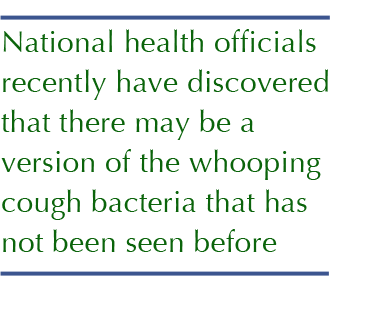home | internet service | web design | business directory | bulletin board | advertise | events calendar | contact | weather | cams

|
Under-immunized  Dr. Ann Diamond of Winthrop's Country Clinic is urging parents to immunize their children for whooping cough. Dr. Ann Diamond of Winthrop's Country Clinic is urging parents to immunize their children for whooping cough.
As of Wednesday (May 2) there were seven confirmed cases of whooping cough in the Methow Valley, according to Dr. Ann Diamond of Winthrop’s Country Clinic, all of them children age 10 to 12 except one. The latest case is a two-year old. The Methow Valley has an exceptionally high rate of unimmunized children, according to state health officials. Methow Valley School Superintendent Mark Wenzel Wednesday notified parents that two of the confirmed cases were students in the district. He added that eight more cases are suspected in the community, but public health officials said that number likely will increase. Diamond, who said she expects more cases in the valley, especially urged parents of unvaccinated children 10 to 12 years old to have them immunized with the Tdap booster vaccine, which helps protect against tetanus, diphtheria and pertussis (whooping cough). Children in this age group who were immunized as infants are due boosters, according to Laura Brumfield, school nurse at the Methow Valley School District, who added that she expects “at least eight” and liikely more cases in the community. Tdap booster vaccine is being given to people as young as seven who have never been immunized or to adults who may require it; vaccinations for whooping cough are advised for adults every 10 years, said Brumfield. The Tdap vaccine costs $50 to $80, according to Diamond. “Anyone can get it whether they’ve been vaccinated or not,” said Diamond of whooping cough, and it can recur in adults who had pertussis as children. But the vaccine does dampen the severe effects of the bacterial infection not only in the infected individual but also keeps it in check in the population as a whole, she explained. The symptoms of whooping cough at first resemble a cold, according to the Centers for Disease Control and Prevention, so infected individuals can unknowingly spread it. Not everyone with pertussis develops the telltale severe cough. Infection occurs when droplets from an infected person who is coughing or sneezing make contact with the mucus membranes of the eyes, nose or mouth of another person; droplets left on hard surfaces can also transmit the illness. Incubation after exposure typically ranges from seven to 10 days but can be as short as four days or as long as 21. An infected person can spread the illness three weeks after they begin coughing, but after five days of treatment with antibiotics they are no longer contagious. “We’re giving out antibiotics in a way we normally never do,” said Diamond. “We’re trying to contain it.” This state now has 1,132 reported cases of pertussis; the comparable period in 2011 saw only 117 cases, according to the state health department, which has declared that an epidemic exists. Whooping cough epidemics occur every three to five years and outbreaks are common. More older children and teens are being affected than has previously been the case because of lack of vaccination, according to health officials. The CDC says 300,000 of the 30 to 50 million people worldwide who get the disease each year die from it. In 2010, 27,550 cases were reported in the United States. The test for pertussis is called PCR and it takes three to five days to obtain results. Diamond said that she believes the first infection occurred in the valley in late March or early April. Three of the cases were reported by the Methow Valley Family Practice in Twisp, according to a staff person in that office. Pertussis is difficult to diagnose in its most virulently contagious stage, which is the first week of the upper respiratory infection, Diamond told Grist. The severe gasping cough does not typically begin until the second or third week. At that point the difficulty in breathing can become so severe that “you cough so hard that you vomit.” Rib fractures, incontinence and pneumonia can be among consequences of pertussis; the most vulnerable are young children. Two children died of pertussis in Washington in 2011. It’s important for women in the late stage of pregnancy to be immunized, she stressed, because doing so confers immunity to the newborn, who cannot be immunized until they are two months old. Infants are most at risk, as they can suffer cerebral bleeding from coughing. “They can die from the bleeding,” Diamond said, while adults who become ill with whooping cough can expect three months of coughing.
“The problem for this community is that we have a lot of under- or un-immunized children,” said Diamond, who estimated that for the valley’s population as a whole, 15 to 20 percent are inadequately protected by vaccines. Brumfield said 15 percent of the school district’s student body is either under or un-immunized, with parents filing exemptions with schools. The recorded state exemption rate for the 2010-11 school year was 6 percent, according to Washington State Department of Public Health immunization program spokeswoman Michele Roberts, but for the Methow Valley School District it was 12.7. The Methow Valley Community School did not file the required vaccination exemption report, Roberts said, and no one was available at the school for comment. “We’re in the highest in the nation,” said Brumfield of the incidence of pertussis in the state. “We have the most lax laws” that permit parents not to immunize their children, she added. “We don’t have enough people immunized. There’s a crack in the protection that allows it to get out of control,” Diamond said of the pertussis outbreak, which she described as the biggest she’s seen in 16 years of practice here. The state legislature last year passed a law that requires parents to present to their child’s school written documentation that they have consulted a health professional if they chose not to vaccinate their child. “Man, oh, man, were people angry!” Diamond recalled. However, she added that pertussis is less clear cut than other communicable diseases. “If we knew immunized people were protected, then (mandatory) exclusion (of the unvaccinated from schools) would make sense.” Exclusion for whooping cough is “a legal and political nightmare,” she added. Nonetheless, Kittitas County’s health department recently became the first county in the state to require that schools mandatorily exclude any unvaccinated child if one case of a communicable disease is confirmed in the school. “Kittitas crossed the line,” Diamond said. Okanogan County health officials “at this point have chosen not to do that,” said Lauri Jones, Okanogan County community health director. Instead, she said, they are hoping parents will either keep their unvaccinated children at home or vaccinate them, she said. She added that in this county, voluntary measures often work better than government-imposed ones. However, she added that the health department wants the school districts themselves to institute mandatory exclusions of unvaccinated children if it’s warranted. For now Jones stressed that it’s important that parents who choose not to vaccinate their children take the responsibility for that decision by keeping their children at home if they become ill. “Those kids are highly contagious,” she stressed. Diamond noted that some parents deliberately choose not to vaccinate their children, either from religious beliefs or other reasons. But doing so can threaten not only the individual child’s health but also that of people in the larger community, said Diamond. She added that she’d like to see a dialogue started in this community about the role of vaccination in society. “Everyone respects the right of parents to decide what’s right for their children,” said Diamond. “But who decides what’s best for the community?” 5/3/2012 Comments Of interest, perhaps: http://www.health-liberty.org/sites/healthliberty/vaccines.aspx 10 Truths About Vaccines By: Barbara Fisher Barbara Loe Fisher, of National Vaccine Information Center (NVIC) Vaccines contain toxic ingredients that have not been adequately evaluated for long term adverse effects on humans The biological mechanisms for vaccine induced brain and immune dysfunction and vaccine induced immunity have not been scientifically established Most vaccine studies alleging that vaccines carry few risks are methodologically flawed and funded by Pharma or government Vaccine failures are not being counted in vaccine cost or risk benefit analyses In the U.S., vaccine manufacturers have been shielded from all liability for vaccine injuries and deaths - even if they could have made a safer vaccine - while the government has awarded more than $2B to the vaccine injured. Diseases that do not fit the smallpox or polio model in terms of morbidity and mortality are now being mandated in the U.S. The U.S. mandates the use of more vaccines than any other nation in the world but has one of the worst infant mortality rates and chronic disease and disability rates of all developed nations. While the numbers of vaccines given to children have doubled in the past quarter century and the numbers of children exposed to childhood infectious diseases has decreased, there has been a corresponding increase in the numbers of children suffering with chronic illness: 1 child in 6 is learning disabled; 1 in 9 has asthma; 1 in 110 develops autism; 1 in 450 is diabetic. One size fits all vaccine mandates do not respect biodiversity. Individuals, who are genetically and biologically vulnerable to vaccine injury and death, are being forced to bear all the burden to achieve the illusive "herd immunity." There are hundreds of new vaccines being developed in more than 3,000 clinical trials worldwide as the pharmaceutical transitions from drug to vaccine dependence for economic stability, while the Pharma lobby has joined with medical organizations receiving money from Pharma to eliminate all non-medical exemptions to vaccination in the U.S. and advocating a growing list of societal punishments for non-compliance (no public education, no health insurance, no job). Lawrence David Hooper Twisp Interesting article at link below for those who want to make an informed decision: http://therefusers.com/refusers-newsroom/if-your-doctor-insists-that-vaccines-are-safe-then-have-them-sign-this-form-dr-dave-mihalovic/#comment-3702 "By Dr. Dave Mihalovic May 2, 2012 The average person that consents to a vaccine injection, either for themselves or for their children, genuinely believes it is for the betterment of health. What they are not aware of is that even their doctor is likely unfamiliar with the toxic ingredients contained in vaccines which can immediately begin to degrade both short- and long-term health. If your doctor insists that vaccines are safe, then they should have absolutely no problem in signing this form so that you may archive it for your own records on the event of an adverse reaction." And here is a site that will tell you exactly what ingredients are in any vaccination: http://www.vaccine-tlc.org/ Lawrence Hooper Twisp Another interesting article: http://therefusers.com/refusers-newsroom/80-to-90-of-wa-state-pertussis-cases-are-in-the-vaccinated-skagit-county-health-department/ Lawrence Hooper Twisp
|
 National health officials recently have discovered that there may be a version of the whooping cough bacteria that has not been seen before, Diamond said. “We don’t know if there’s a mutation of a species of pertussis,” she said. If so, she added, “We don’t know if our current vaccine will cover it.” It would take weeks of laboratory work to learn if the suspect version has appeared in the valley, she added.
National health officials recently have discovered that there may be a version of the whooping cough bacteria that has not been seen before, Diamond said. “We don’t know if there’s a mutation of a species of pertussis,” she said. If so, she added, “We don’t know if our current vaccine will cover it.” It would take weeks of laboratory work to learn if the suspect version has appeared in the valley, she added.